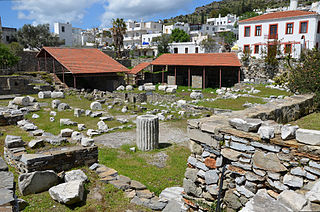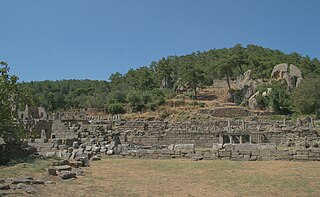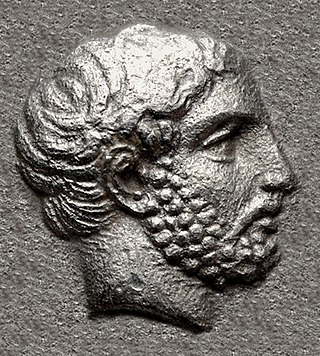This article concerns the period 349 BC – 340 BC.
This article concerns the period 369 BC – 360 BC
This article concerns the period 359 BC – 350 BC.
This article concerns the period 339 BC – 330 BC.
Year 340 BC was a year of the pre-Julian Roman calendar. At the time it was known as the Year of the Consulship of Torquatus and Mus. The denomination 340 BC for this year has been used since the early medieval period, when the Anno Domini calendar era became the prevalent method in Europe for naming years.

The Mausoleum at Halicarnassus or Tomb of Mausolus was a tomb built between 353 and 350 BC in Halicarnassus for Mausolus, an Anatolian from Caria and a satrap in the Achaemenid Empire, and his sister-wife Artemisia II of Caria. The structure was designed by the Greek architects Satyros and Pythius of Priene. Its elevated tomb structure is derived from the tombs of neighbouring Lycia, a territory Mausolus had invaded and annexed c. 360 BC, such as the Nereid Monument.

Caria was a region of western Anatolia extending along the coast from mid-Ionia (Mycale) south to Lycia and east to Phrygia. The Ionian and Dorian Greeks colonized the west of it and joined the Carian population in forming Greek-dominated states there. Carians were described by Herodotus as being of Minoan descent, while he reports that the Carians themselves maintained that they were Anatolian mainlanders intensely engaged in seafaring and were akin to the Mysians and the Lydians. The Carians spoke Carian, a native Anatolian language closely related to Luwian. Also closely associated with the Carians were the Leleges, which could be an earlier name for Carians.
Year 353 BC was a year of the pre-Julian Roman calendar. At the time, it was known as the Year of the Consulship of Peticus and Poplicola. The denomination 353 BC for this year has been used since the early medieval period, when the Anno Domini calendar era became the prevalent method in Europe for naming years.
Year 354 BC was a year of the pre-Julian Roman calendar. At the time, it was known as the Year of the Consulship of Ambustus and Crispinus. The denomination 354 BC for this year has been used since the early medieval period, when the Anno Domini calendar era became the prevalent method in Europe for naming years.

Mausolus was a ruler of Caria and a satrap of the Achaemenid Empire. He enjoyed the status of king or dynast by virtue of the powerful position created by his father Hecatomnus, who was the first satrap of Caria from the hereditary Hecatomnid dynasty. Alongside Caria, Mausolus also ruled Lycia and parts of Ionia and the Dodecanese islands. He is best known for his monumental tomb and one of the Seven Wonders of the Ancient World, the Mausoleum at Halicarnassus, the construction of which has traditionally been ascribed to his wife and sister Artemisia.

Halicarnassus was an ancient Greek city in Caria, in Anatolia. It was located in southwest Caria, on an advantageous site on the Gulf of Gökova, which is now in Bodrum, Turkey. The city was famous for the Mausoleum of Halicarnassus, also known simply as the Tomb of Mausolus, whose name provided the origin of the word "mausoleum". The mausoleum, built from 353 to 350 BC, ranked as one of the seven wonders of the ancient world.

Artemisia II of Caria was a naval strategist, commander and the sister and the successor of Mausolus, ruler of Caria. Mausolus was a satrap of the Achaemenid Empire, yet enjoyed the status of king or dynast of the Hecatomnid dynasty. After the death of her brother/husband, Artemisia reigned for two years, from 353 to 351 BCE. Her ascension to the throne prompted a revolt in some of the island and coastal cities under her command due to their objection to a female ruler. Her administration was conducted on the same principles as that of her husband; in particular, she supported the oligarchical party on the island of Rhodes.

Labraunda is an ancient archaeological site five kilometers west of Ortaköy, Muğla Province, Turkey, in the mountains near the coast of Caria. In ancient times, it was held sacred by Carians and Mysians alike. The site amid its sacred plane trees was enriched in the Hellenistic style by the Hecatomnid dynasty of Mausolus, satrap of Persian Caria, and also later by his successor and brother Idrieus; Labranda was the dynasty's ancestral sacred shrine. The prosperity of a rapidly hellenised Caria occurred in the during the 4th century BCE. Remains of Hellenistic houses and streets can still be traced, and there are numerous inscriptions. The cult icon here was a local Zeus Labrandeus, a standing Zeus with the tall lotus-tipped scepter upright in his left hand and the double-headed axe, the labrys, over his right shoulder. The cult statue was the gift of the founder of the dynasty, Hecatomnus himself, recorded in a surviving inscription.

Ada of Caria was a member of the House of Hecatomnus and ruler of Caria during the mid-4th century BC, first as Persian Satrap and later as Queen under the auspices of Alexander III of Macedon.

Bryaxis was a Greek sculptor. He created the sculptures on the north side of the mausoleum of Maussollos at Halicarnassus which was commissioned by the queen Artemisia II of Caria in memory of her brother and husband, Mausolus. The three other greatest sculptors of their time, Leochares, Scopas and Timotheus, were each one responsible for one side of the grave. The tomb was completed three years after the death of Mausolus and one year after the death of Artemisia. Some authors allege that Bryaxis created a famous colossal statue of Serapis in the temple at Alexandria; however, according to Michaelis, Athenodoros Cananites expressly pointed out that the Bryaxis connected with the Alexandrian statue was merely a namesake of the famous Bryaxis. The works of Bryaxis include a bronze statue of Seleucus, king of Syria, five huge statues at Rhodes, and a statue of Apollo at Daphne near Antioch.

Pixodarus or Pixodaros, was a satrap of Caria, nominally the Achaemenid Empire Satrap, who enjoyed the status of king or dynast by virtue of the powerful position his predecessors of the House of Hecatomnus created when they succeeded the assassinated Persian Satrap Tissaphernes in the Carian satrapy. Lycia was also ruled by the Carian dynasts since the time of Mausolus, and the name of Pixodarus as ruler appears in the Xanthos trilingual inscription in Lycia.

Hecatomnus of Mylasa or Hekatomnos was an early 4th-century BC ruler of Caria. He was the satrap (governor) of Caria for the Persian Achaemenid king Artaxerxes II. However, the basis for Hecatomnus' political power was twofold: he was both a high appointed Persian official and a powerful local dynast, who founded the hereditary dynasty of the Hecatomnids. The Hecatomnids followed the earlier autochthonous dynasty of the Lygdamids in Caria.

Idrieus, or Hidrieus was a ruler of Caria as a Satrap under the Achaemenid Empire. Alongside his sister and wife Ada, he enjoyed the status of king or dynast by virtue of the powerful position he inherited from his predecessors of the House of Hecatomnus.
Satyros or Satyrus was a Greek architect in the 4th century BC. Along with Pythius of Priene, he designed and oversaw the construction of the Mausoleum at Halicarnassus.

The Hecatomnid dynasty or Hecatomnids were the rulers of Caria and surrounding areas c. 395 – c. 330 BCE. They were satraps (governors) under the Achaemenid Empire, although they ruled with considerable autonomy as a hereditary dynasty. The dynasty had previously ruled the city of Mylasa, which became the capital of Hecatomnus, the first indigenous satrap of Caria. The dynastic capital was moved to Halicarnassus by Mausolus and Artemisia, who built the Mausoleum at Halicarnassus, one of the Seven Wonders of the Ancient World, there. The dynasty survived the conquest of the Achaemenid Empire by Alexander the Great when Ada I, the final Hecatomnid ruler of Caria, adopted Alexander the Great as her son. The small family was remarkable for containing so many sets of married siblings.











